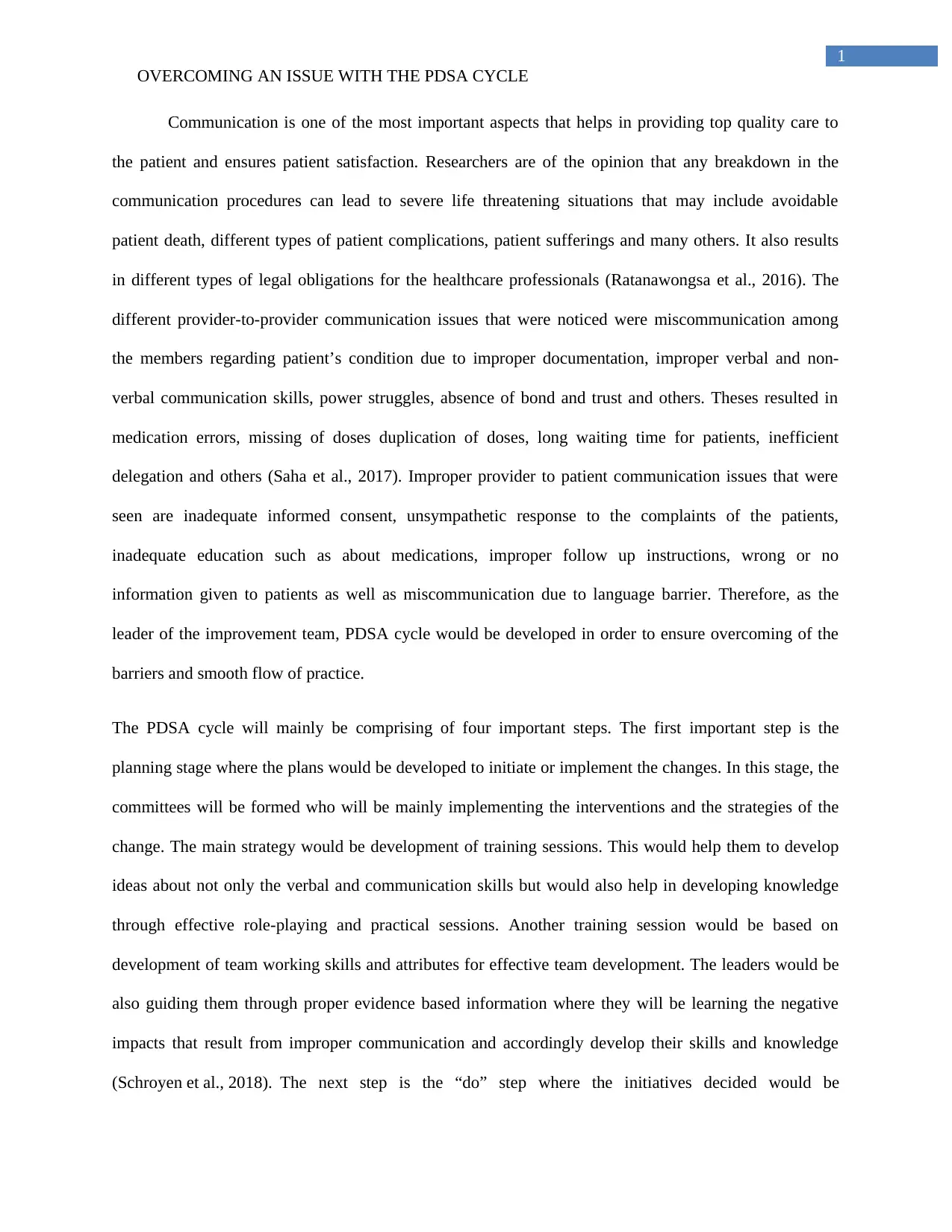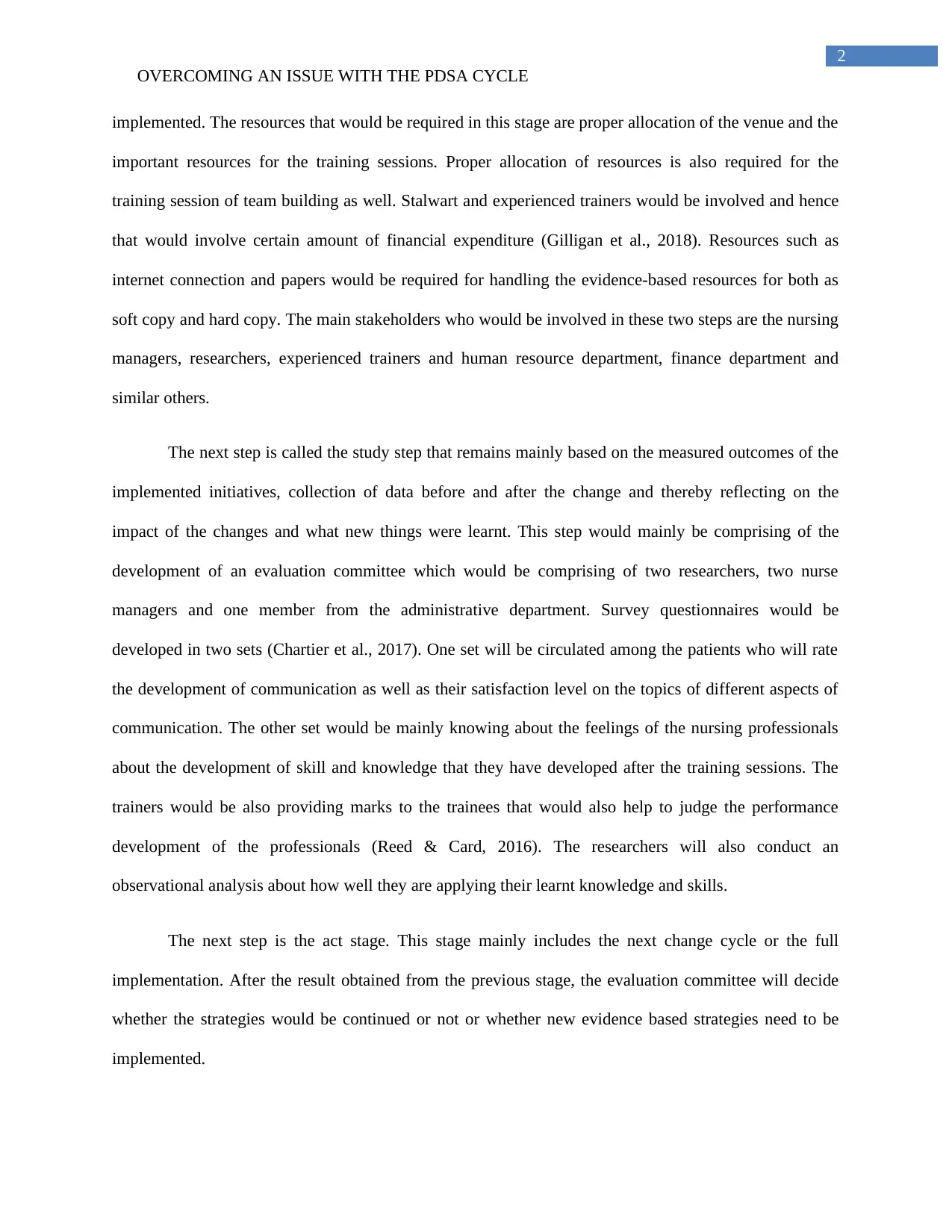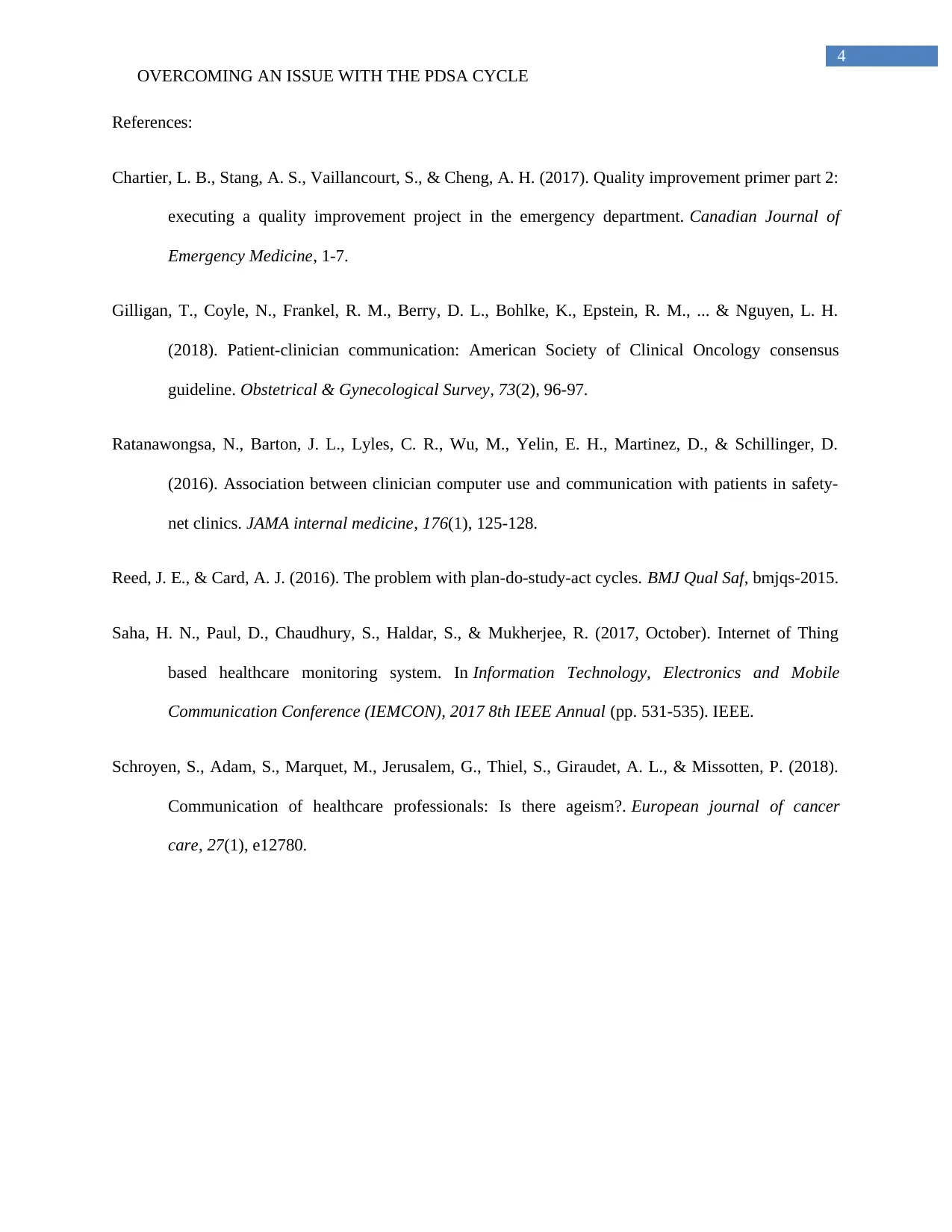PDSA Cycle Application: Improving Communication in Healthcare
VerifiedAdded on 2023/06/10
|5
|1188
|423
Essay
AI Summary
This essay discusses the importance of effective communication in healthcare and how breakdowns in communication can lead to severe consequences. It identifies common provider-to-provider and provider-to-patient communication issues. The solution proposes using the PDSA (Plan-Do-Study-Act) cycle to overcome these barriers. The 'Plan' stage involves developing training sessions focused on verbal and nonverbal communication skills, team building, and evidence-based information on the impact of poor communication. The 'Do' stage focuses on implementing these training initiatives, allocating necessary resources, and involving stakeholders like nursing managers, trainers, and HR. The 'Study' stage includes evaluating the impact of the changes through surveys and observational analysis. Finally, the 'Act' stage involves deciding whether to continue, modify, or implement new strategies based on the results obtained. The essay concludes that the PDSA cycle is a valuable tool for improving communication and mitigating related issues in healthcare settings.

Running head: OVERCOMING AN ISSUE WITH THE PDSA CYCLE
OVERCOMING AN ISSUE WITH THE PDSA CYCLE
Name of the student:
Name of the university:
Author note:
OVERCOMING AN ISSUE WITH THE PDSA CYCLE
Name of the student:
Name of the university:
Author note:
Paraphrase This Document
Need a fresh take? Get an instant paraphrase of this document with our AI Paraphraser

1
OVERCOMING AN ISSUE WITH THE PDSA CYCLE
Communication is one of the most important aspects that helps in providing top quality care to
the patient and ensures patient satisfaction. Researchers are of the opinion that any breakdown in the
communication procedures can lead to severe life threatening situations that may include avoidable
patient death, different types of patient complications, patient sufferings and many others. It also results
in different types of legal obligations for the healthcare professionals (Ratanawongsa et al., 2016). The
different provider-to-provider communication issues that were noticed were miscommunication among
the members regarding patient’s condition due to improper documentation, improper verbal and non-
verbal communication skills, power struggles, absence of bond and trust and others. Theses resulted in
medication errors, missing of doses duplication of doses, long waiting time for patients, inefficient
delegation and others (Saha et al., 2017). Improper provider to patient communication issues that were
seen are inadequate informed consent, unsympathetic response to the complaints of the patients,
inadequate education such as about medications, improper follow up instructions, wrong or no
information given to patients as well as miscommunication due to language barrier. Therefore, as the
leader of the improvement team, PDSA cycle would be developed in order to ensure overcoming of the
barriers and smooth flow of practice.
The PDSA cycle will mainly be comprising of four important steps. The first important step is the
planning stage where the plans would be developed to initiate or implement the changes. In this stage, the
committees will be formed who will be mainly implementing the interventions and the strategies of the
change. The main strategy would be development of training sessions. This would help them to develop
ideas about not only the verbal and communication skills but would also help in developing knowledge
through effective role-playing and practical sessions. Another training session would be based on
development of team working skills and attributes for effective team development. The leaders would be
also guiding them through proper evidence based information where they will be learning the negative
impacts that result from improper communication and accordingly develop their skills and knowledge
(Schroyen et al., 2018). The next step is the “do” step where the initiatives decided would be
OVERCOMING AN ISSUE WITH THE PDSA CYCLE
Communication is one of the most important aspects that helps in providing top quality care to
the patient and ensures patient satisfaction. Researchers are of the opinion that any breakdown in the
communication procedures can lead to severe life threatening situations that may include avoidable
patient death, different types of patient complications, patient sufferings and many others. It also results
in different types of legal obligations for the healthcare professionals (Ratanawongsa et al., 2016). The
different provider-to-provider communication issues that were noticed were miscommunication among
the members regarding patient’s condition due to improper documentation, improper verbal and non-
verbal communication skills, power struggles, absence of bond and trust and others. Theses resulted in
medication errors, missing of doses duplication of doses, long waiting time for patients, inefficient
delegation and others (Saha et al., 2017). Improper provider to patient communication issues that were
seen are inadequate informed consent, unsympathetic response to the complaints of the patients,
inadequate education such as about medications, improper follow up instructions, wrong or no
information given to patients as well as miscommunication due to language barrier. Therefore, as the
leader of the improvement team, PDSA cycle would be developed in order to ensure overcoming of the
barriers and smooth flow of practice.
The PDSA cycle will mainly be comprising of four important steps. The first important step is the
planning stage where the plans would be developed to initiate or implement the changes. In this stage, the
committees will be formed who will be mainly implementing the interventions and the strategies of the
change. The main strategy would be development of training sessions. This would help them to develop
ideas about not only the verbal and communication skills but would also help in developing knowledge
through effective role-playing and practical sessions. Another training session would be based on
development of team working skills and attributes for effective team development. The leaders would be
also guiding them through proper evidence based information where they will be learning the negative
impacts that result from improper communication and accordingly develop their skills and knowledge
(Schroyen et al., 2018). The next step is the “do” step where the initiatives decided would be

2
OVERCOMING AN ISSUE WITH THE PDSA CYCLE
implemented. The resources that would be required in this stage are proper allocation of the venue and the
important resources for the training sessions. Proper allocation of resources is also required for the
training session of team building as well. Stalwart and experienced trainers would be involved and hence
that would involve certain amount of financial expenditure (Gilligan et al., 2018). Resources such as
internet connection and papers would be required for handling the evidence-based resources for both as
soft copy and hard copy. The main stakeholders who would be involved in these two steps are the nursing
managers, researchers, experienced trainers and human resource department, finance department and
similar others.
The next step is called the study step that remains mainly based on the measured outcomes of the
implemented initiatives, collection of data before and after the change and thereby reflecting on the
impact of the changes and what new things were learnt. This step would mainly be comprising of the
development of an evaluation committee which would be comprising of two researchers, two nurse
managers and one member from the administrative department. Survey questionnaires would be
developed in two sets (Chartier et al., 2017). One set will be circulated among the patients who will rate
the development of communication as well as their satisfaction level on the topics of different aspects of
communication. The other set would be mainly knowing about the feelings of the nursing professionals
about the development of skill and knowledge that they have developed after the training sessions. The
trainers would be also providing marks to the trainees that would also help to judge the performance
development of the professionals (Reed & Card, 2016). The researchers will also conduct an
observational analysis about how well they are applying their learnt knowledge and skills.
The next step is the act stage. This stage mainly includes the next change cycle or the full
implementation. After the result obtained from the previous stage, the evaluation committee will decide
whether the strategies would be continued or not or whether new evidence based strategies need to be
implemented.
OVERCOMING AN ISSUE WITH THE PDSA CYCLE
implemented. The resources that would be required in this stage are proper allocation of the venue and the
important resources for the training sessions. Proper allocation of resources is also required for the
training session of team building as well. Stalwart and experienced trainers would be involved and hence
that would involve certain amount of financial expenditure (Gilligan et al., 2018). Resources such as
internet connection and papers would be required for handling the evidence-based resources for both as
soft copy and hard copy. The main stakeholders who would be involved in these two steps are the nursing
managers, researchers, experienced trainers and human resource department, finance department and
similar others.
The next step is called the study step that remains mainly based on the measured outcomes of the
implemented initiatives, collection of data before and after the change and thereby reflecting on the
impact of the changes and what new things were learnt. This step would mainly be comprising of the
development of an evaluation committee which would be comprising of two researchers, two nurse
managers and one member from the administrative department. Survey questionnaires would be
developed in two sets (Chartier et al., 2017). One set will be circulated among the patients who will rate
the development of communication as well as their satisfaction level on the topics of different aspects of
communication. The other set would be mainly knowing about the feelings of the nursing professionals
about the development of skill and knowledge that they have developed after the training sessions. The
trainers would be also providing marks to the trainees that would also help to judge the performance
development of the professionals (Reed & Card, 2016). The researchers will also conduct an
observational analysis about how well they are applying their learnt knowledge and skills.
The next step is the act stage. This stage mainly includes the next change cycle or the full
implementation. After the result obtained from the previous stage, the evaluation committee will decide
whether the strategies would be continued or not or whether new evidence based strategies need to be
implemented.
⊘ This is a preview!⊘
Do you want full access?
Subscribe today to unlock all pages.

Trusted by 1+ million students worldwide

3
OVERCOMING AN ISSUE WITH THE PDSA CYCLE
Therefore, from the above discussion, one can easily understand how PDSA cycle successfully
helps in developing effective plans for overcoming various barriers and helps in mitigating various issues
successfully.
OVERCOMING AN ISSUE WITH THE PDSA CYCLE
Therefore, from the above discussion, one can easily understand how PDSA cycle successfully
helps in developing effective plans for overcoming various barriers and helps in mitigating various issues
successfully.
Paraphrase This Document
Need a fresh take? Get an instant paraphrase of this document with our AI Paraphraser

4
OVERCOMING AN ISSUE WITH THE PDSA CYCLE
References:
Chartier, L. B., Stang, A. S., Vaillancourt, S., & Cheng, A. H. (2017). Quality improvement primer part 2:
executing a quality improvement project in the emergency department. Canadian Journal of
Emergency Medicine, 1-7.
Gilligan, T., Coyle, N., Frankel, R. M., Berry, D. L., Bohlke, K., Epstein, R. M., ... & Nguyen, L. H.
(2018). Patient-clinician communication: American Society of Clinical Oncology consensus
guideline. Obstetrical & Gynecological Survey, 73(2), 96-97.
Ratanawongsa, N., Barton, J. L., Lyles, C. R., Wu, M., Yelin, E. H., Martinez, D., & Schillinger, D.
(2016). Association between clinician computer use and communication with patients in safety-
net clinics. JAMA internal medicine, 176(1), 125-128.
Reed, J. E., & Card, A. J. (2016). The problem with plan-do-study-act cycles. BMJ Qual Saf, bmjqs-2015.
Saha, H. N., Paul, D., Chaudhury, S., Haldar, S., & Mukherjee, R. (2017, October). Internet of Thing
based healthcare monitoring system. In Information Technology, Electronics and Mobile
Communication Conference (IEMCON), 2017 8th IEEE Annual (pp. 531-535). IEEE.
Schroyen, S., Adam, S., Marquet, M., Jerusalem, G., Thiel, S., Giraudet, A. L., & Missotten, P. (2018).
Communication of healthcare professionals: Is there ageism?. European journal of cancer
care, 27(1), e12780.
OVERCOMING AN ISSUE WITH THE PDSA CYCLE
References:
Chartier, L. B., Stang, A. S., Vaillancourt, S., & Cheng, A. H. (2017). Quality improvement primer part 2:
executing a quality improvement project in the emergency department. Canadian Journal of
Emergency Medicine, 1-7.
Gilligan, T., Coyle, N., Frankel, R. M., Berry, D. L., Bohlke, K., Epstein, R. M., ... & Nguyen, L. H.
(2018). Patient-clinician communication: American Society of Clinical Oncology consensus
guideline. Obstetrical & Gynecological Survey, 73(2), 96-97.
Ratanawongsa, N., Barton, J. L., Lyles, C. R., Wu, M., Yelin, E. H., Martinez, D., & Schillinger, D.
(2016). Association between clinician computer use and communication with patients in safety-
net clinics. JAMA internal medicine, 176(1), 125-128.
Reed, J. E., & Card, A. J. (2016). The problem with plan-do-study-act cycles. BMJ Qual Saf, bmjqs-2015.
Saha, H. N., Paul, D., Chaudhury, S., Haldar, S., & Mukherjee, R. (2017, October). Internet of Thing
based healthcare monitoring system. In Information Technology, Electronics and Mobile
Communication Conference (IEMCON), 2017 8th IEEE Annual (pp. 531-535). IEEE.
Schroyen, S., Adam, S., Marquet, M., Jerusalem, G., Thiel, S., Giraudet, A. L., & Missotten, P. (2018).
Communication of healthcare professionals: Is there ageism?. European journal of cancer
care, 27(1), e12780.
1 out of 5
Related Documents
Your All-in-One AI-Powered Toolkit for Academic Success.
+13062052269
info@desklib.com
Available 24*7 on WhatsApp / Email
![[object Object]](/_next/static/media/star-bottom.7253800d.svg)
Unlock your academic potential
Copyright © 2020–2025 A2Z Services. All Rights Reserved. Developed and managed by ZUCOL.





